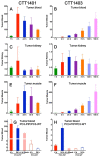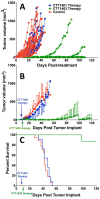177Lu-Labeled Phosphoramidate-Based PSMA Inhibitors: The Effect of an Albumin Binder on Biodistribution and Therapeutic Efficacy in Prostate Tumor-Bearing Mice
- PMID: 28638478
- PMCID: PMC5479279
- DOI: 10.7150/thno.18719
177Lu-Labeled Phosphoramidate-Based PSMA Inhibitors: The Effect of an Albumin Binder on Biodistribution and Therapeutic Efficacy in Prostate Tumor-Bearing Mice
Abstract
Prostate-specific membrane antigen (PSMA) continues to be an active biomarker for small-molecule PSMA-targeted imaging and therapeutic agents for prostate cancer and various non-prostatic tumors that are characterized by PSMA expression on their neovasculature. One of the challenges for small-molecule PSMA inhibitors with respect to delivering therapeutic payloads is their rapid renal clearance. In order to overcome this pharmacokinetic challenge, we outfitted a 177Lu-labeled phosphoramidate-based PSMA inhibitor (CTT1298) with an albumin-binding motif (CTT1403) and compared its in vivo performance with that of an analogous compound lacking the albumin-binding motif (CTT1401). The radiolabeling of CTT1401 and CTT1403 was achieved using click chemistry to connect 177Lu-DOTA-N3 to the dibenzocyclooctyne (DBCO)-bearing CTT1298 inhibitor cores. A direct comparison in vitro and in vivo performance was made for CTT1401 and CTT1403; the specificity and efficacy by means of cellular uptake and internalization, biodistribution, and therapeutic efficacy were determined for both compounds. While both compounds displayed excellent uptake and rapid internalization in PSMA+ PC3-PIP cells, the albumin binding moiety in CTT1403 conferred clear advantages to the PSMA-inhibitor scaffold including increased circulating half-life and prostate tumor uptake that continued to increase up to 168 h post-injection. This increased tumor uptake translated into superior therapeutic efficacy of CTT1403 in PSMA+ PC3-PIP human xenograft tumors.
Keywords: 177Lu; PSMA; albumin; phosphoramidate; radiotherapy..
Conflict of interest statement
Competing Interests: Dr. Langton-Webster serves as the Chief Executive Officer for Cancer Targeted Technology. Dr. Berkman serves at the Chief Science Officer for Cancer Targeted Technology and is the inventor of the CTT1298 PSMA inhibitor scaffold.
Figures






Comment in
-
Should Low Molecular Weight PSMA Targeted Ligands Get Bigger and Use Albumin Ligands for PSMA Targeting?Theranostics. 2017 Apr 1;7(7):1940-1941. doi: 10.7150/thno.20284. eCollection 2017. Theranostics. 2017. PMID: 28638479 Free PMC article.
Similar articles
-
Preclinical Dosimetry, Imaging, and Targeted Radionuclide Therapy Studies of Lu-177-Labeled Albumin-Binding, PSMA-Targeted CTT1403.Mol Imaging Biol. 2020 Apr;22(2):274-284. doi: 10.1007/s11307-019-01404-8. Mol Imaging Biol. 2020. PMID: 31321650 Free PMC article.
-
Preclinical Development of Novel PSMA-Targeting Radioligands: Modulation of Albumin-Binding Properties To Improve Prostate Cancer Therapy.Mol Pharm. 2018 Jun 4;15(6):2297-2306. doi: 10.1021/acs.molpharmaceut.8b00152. Epub 2018 May 2. Mol Pharm. 2018. PMID: 29684274
-
Enhancing Treatment Efficacy of 177Lu-PSMA-617 with the Conjugation of an Albumin-Binding Motif: Preclinical Dosimetry and Endoradiotherapy Studies.Mol Pharm. 2018 Nov 5;15(11):5183-5191. doi: 10.1021/acs.molpharmaceut.8b00720. Epub 2018 Oct 5. Mol Pharm. 2018. PMID: 30251544
-
Inhibitors of prostate-specific membrane antigen in the diagnosis and therapy of metastatic prostate cancer - a review of patent literature.Expert Opin Ther Pat. 2021 Jun;31(6):525-547. doi: 10.1080/13543776.2021.1878145. Epub 2021 Apr 16. Expert Opin Ther Pat. 2021. PMID: 33459068 Review.
-
Prostate-specific membrane antigen theranostics: therapy with lutetium-177.Curr Opin Urol. 2018 Mar;28(2):197-204. doi: 10.1097/MOU.0000000000000486. Curr Opin Urol. 2018. PMID: 29278583 Review.
Cited by
-
Therapeutic potential of targeting mirnas to prostate cancer tumors: using psma as an active target.Mol Cell Oncol. 2022 Oct 24;9(1):2136476. doi: 10.1080/23723556.2022.2136476. eCollection 2022. Mol Cell Oncol. 2022. PMID: 36313480 Free PMC article. Review.
-
Targeted Radionuclide Therapy: New Advances for Improvement of Patient Management and Response.Cancers (Basel). 2019 Feb 25;11(2):268. doi: 10.3390/cancers11020268. Cancers (Basel). 2019. PMID: 30823564 Free PMC article. Review.
-
Development and Application of Radioactive Ligands Targeting Fibroblasts with Albumin-Binding Sites.Mol Cancer Ther. 2025 Aug 1;24(8):1186-1196. doi: 10.1158/1535-7163.MCT-24-1108. Mol Cancer Ther. 2025. PMID: 40177850 Free PMC article.
-
Application of the Chelator-Based Clickable Radiotheranostic Platform to Moderate-Molecular-Weight Ligands.ACS Med Chem Lett. 2022 Sep 2;13(10):1642-1647. doi: 10.1021/acsmedchemlett.2c00320. eCollection 2022 Oct 13. ACS Med Chem Lett. 2022. PMID: 36262405 Free PMC article.
-
Repurposing of PSMA-targeted diagnostic and therapeutic agents for the detection and treatment of giant cell tumors of bone.Front Oncol. 2024 Nov 15;14:1504514. doi: 10.3389/fonc.2024.1504514. eCollection 2024. Front Oncol. 2024. PMID: 39619440 Free PMC article.
References
-
- Rosenthal SA, Haseman MK, Polascik TJ. Utility of capromab pendetide (ProstaScint) imaging in the management of prostate cancer. Tech Urol. 2001;7:27–37. - PubMed
-
- Bander NH, Milowsky MI, Nanus DM, Kostakoglu L, Vallabhajosula S, Goldsmith SJ. Phase I trial of 177lutetium-labeled J591, a monoclonal antibody to prostate-specific membrane antigen, in patients with androgen-independent prostate cancer. J Clin Oncol. 2005;23:4591–601. - PubMed
-
- Chu TC, Shieh F, Lavery LA, Levy M, Richards-Kortum R, Korgel BA. et al. Labeling tumor cells with fluorescent nanocrystal-aptamer bioconjugates. Biosens Bioelectron. 2006;21:1859–66. - PubMed
-
- Farokhzad OC, Khademhosseini A, Jon S, Hermmann A, Cheng J, Chin C. et al. Microfluidic system for studying the interaction of nanoparticles and microparticles with cells. Anal Chem. 2005;77:5453–9. - PubMed
-
- Foss CA, Mease RC, Fan H, Wang Y, Ravert HT, Dannals RF. et al. Radiolabeled small-molecule ligands for prostate-specific membrane antigen: in vivo imaging in experimental models of prostate cancer. Clin Cancer Res. 2005;11:4022–8. - PubMed
MeSH terms
Substances
Grants and funding
LinkOut - more resources
Full Text Sources
Other Literature Sources
Medical
Miscellaneous

